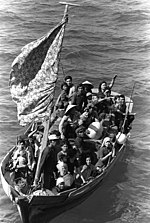History of the Jews in Vietnam
| Part of a series on |
| Jews and Judaism |
|---|
Jews are a minor
Nguyen Dynasty and French protectorate
19th century
The first Jews to visit Vietnam likely arrived during the
The
A coastal and river steamship was later (1920) built in France and christened 'Jules Rueff' to recognize his role in the development of the region's maritime activities.[8] This ship was sunk in 1943 during WWII by the US submarine Bowfin.[9]
Between 1883 and 1886, Jewish soldiers and officers fought in the French army in the
Early 20th century
According to the Universal Jewish Encyclopedia,
The Alliance Israélite Universelle appears to have had some activity in Haiphong during the 1920s.[15]
According to the
World War II and Vichy France
As late as 1939, the estimated combined population of the Jewish communities of
In 1940 the
Democratic Republic of Vietnam
In 1954, with the dissolution of
Ho Chi Minh reportedly suggested in 1946 that North Vietnam could serve as a home base for a Jewish government-in-exile before the establishment of the State of Israel. David Ben-Gurion, then the new executive head of the World Zionist Organization, first spoke of this encounter to the press in 1966.[26]
Republic of Vietnam
In 1971, about 12 French Jews still remained in South Vietnam, all in Saigon.[27] During the Vietnam War, temporary Jewish communities were organized throughout South Vietnam, consisting largely of United States military personnel. Approximately 30,000 Jewish-Americans served in the U.S. Armed Forces in Vietnam; amongst them, Colonel Jack H. Jacobs won the Medal of Honor for heroism for his service.[28][29]
Socialist Republic of Vietnam
Gradually, as the communist government began accepting economic reforms, the number of Jewish visitors to the country increased.
The discovery of the wild
In 2005, the U.S. State Department's "International Religious Freedom Report" noted "There were no reported
In 2006,
Vietnamese refugees in Israel

From 1977 to 1979, the
Prominent Vietnamese in Israel
- Vaan Nguyen (poet and actress), subject of an award-winning documentary The Journey of Vaan Nguyen.[33]
- Dr. Sabine Huynh (translator, sociologist and author[34]), fled Vietnam for France in 1976 and has lived in Israel since 2001.
- Dao Wong (banker), headed Bank Hapoalim in Singapore, now lives in Switzerland.[32]
See also
References
- ^ a b Cassedy, Ellen "Economic opportunities lure Jews to land of Ho Chi Minh" Jewish Telegraphic Agency 2007-09-30 "JTA - Jewish & Israel News". Archived from the original on 7 June 2011. Retrieved 16 April 2010.
- ^ a b International Religious Freedom Report 2005 – Vietnam. U.S. Department of State.
- ^ by Jacob de Haas, published by Behrman's Jewish Book House, 1946, page 404
- ^ "Les Messageries Fluviales de Cochinchine". 7 September 2010.
- ^ http://www.entreprises-coloniales.fr/inde-indochine/Messag._fluv._Coch._1881-1927.pdf [bare URL PDF]
- ^ Jewish Encyclopedia: Rueff, Jules.
- ^ See [1] and footnote xxxv for original French source material, noted as "Datée de Paris le 16 avril 1889. Reproduite dans l'Avenir du Tonkin du samedi 8 juin 1889, N° 156."
- ^ Madrolle, Claudius To Angkor Société d'éditions géographiques, maritimes et coloniales, 1939 and additional reference is made to travel on this ship in Horace Bleackley's A Tour in Southern Asia: (Indo-China, Malaya, Java, Sumatra, and Ceylon, 1925–1926), published by John Lane, London 1928
- ^ "Navires avant 1970".
- ^ GeneaWiki: Médaille du Tonkin (in French)
- ^ GeneaWiki: Ordre royal du Cambodge (in French)
- ISBN 0-8047-2633-7Pages 47–48
- ^ Landman, Isaac The Universal Jewish Encyclopedia...: An Authoritative and Popular Presentation of Jews and Judaism Since the Earliest Times, 1942 Page 626; Comay, Joan & Cohn-Sherbok, Lavinia Who's Who in Jewish History: After the Period of the Old Testament
Routledge, 1995 ISBN 0-415-12583-9Page 231
- ^ "École française d'Extrême-Orient: History". Archived from the original on 11 October 2008. Retrieved 2 November 2008.
- ^ "Alliance Israélite Universelle: Nord-Vietnam". Archived from the original on 13 October 2008. Retrieved 18 August 2008.
- ^ Appy, Christian G. Cold War Constructions: The Political Culture of United States Imperialism, 1945–1966 University of Massachusetts Press, 2000, Page 279
- ISBN 0-631-21013-X
- ^ Statistics of Jews, American Jewish Committee, 1940.
- ISBN 0-8047-5047-5Page 145
- ISBN 0-8248-2868-2
- ISBN 0-8047-5047-5Pages 144–145
- ^ "The Lippmann Affair". 15 November 2015.
- ISBN 0-7391-1146-9Pages 65–66
- ISBN 0-253-33854-9Page 69
- ISBN 0-8143-1843-6Page 472
- ^ "Ben-gurion Reveals Suggestion of North Vietnam's Communist Leader". Jewish Telegraphic Agency. 8 November 1966. Retrieved 10 July 2020.
- ISBN 0-233-96144-5Page 74
- ^ Jewish-American military participation Archived 1 May 2009 at the Wayback Machine. Fort Gordon Equal Opportunity Office.
- ISBN 978-0-8010-1119-1
- ^ עלה לרשת: הסרט התיעודי על חב"ד בוויאטנם ● לצפייה (in Hebrew and Russian). Chabad. Retrieved 14 April 2015.
- ^ Frank, Benn. "Visiting The Jews of Vietnam". The Baltimore Jewish Times. Archived from the original on 13 August 2016. Retrieved 5 July 2016 – via Be'chol Lashon.
- ^ a b c Weinglass, Simona (20 September 2015). "35 years on, where are Israel's Vietnamese refugees?". The Times of Israel. Retrieved 30 June 2016.
- ^ Documentary, March 20, 2013. (5 August 2010). "The Journey of Vaan Nguyen". Zygote Films. Retrieved 30 June 2016 – via Vimeo.
{{cite web}}: CS1 maint: multiple names: authors list (link) CS1 maint: numeric names: authors list (link) - ^ The Dudley Review 6 (2000), "Meta-Morphology", p. 61-66 ; The Dudley Review 7,1 (Spring 2001), "State of grace", p. 9-14, avec son propre travail photographique – photographies en noir et blanc : "Saint-Ives" (p. 60), "Mount Auburn Cemetery" (p. 61), "The biter bitten" (p. 62), "Les jardins de la fontaine" (p. 63), "Régis et Sophie" (p. 64), "Empire State Building" (p. 65)
